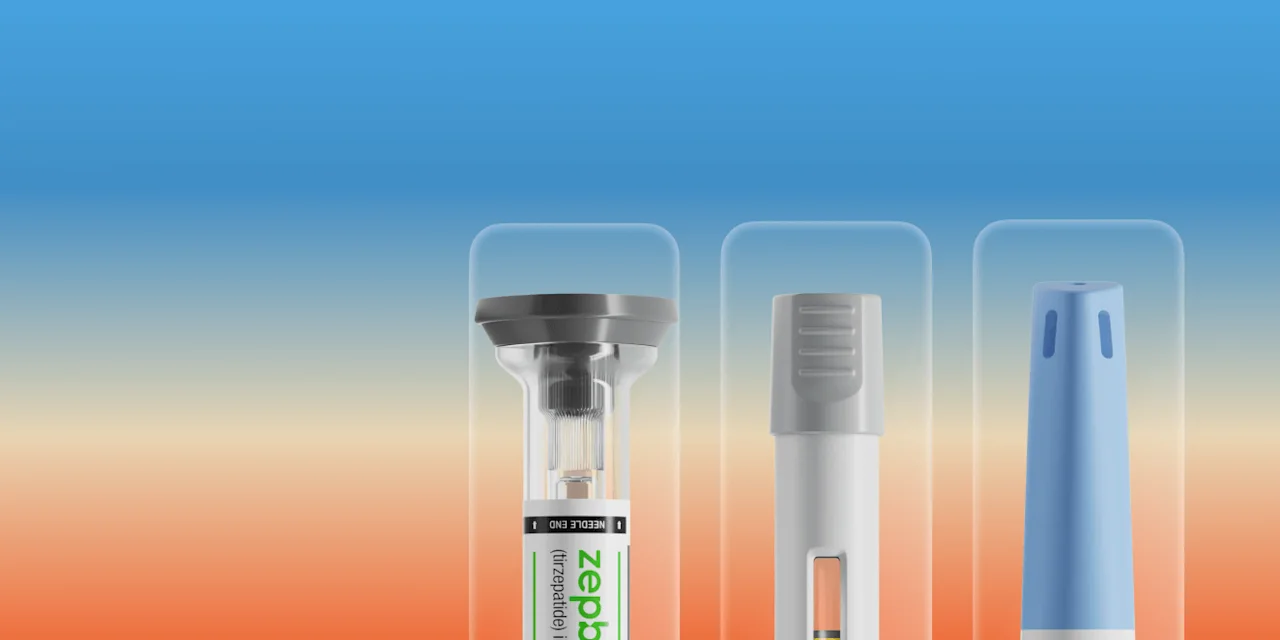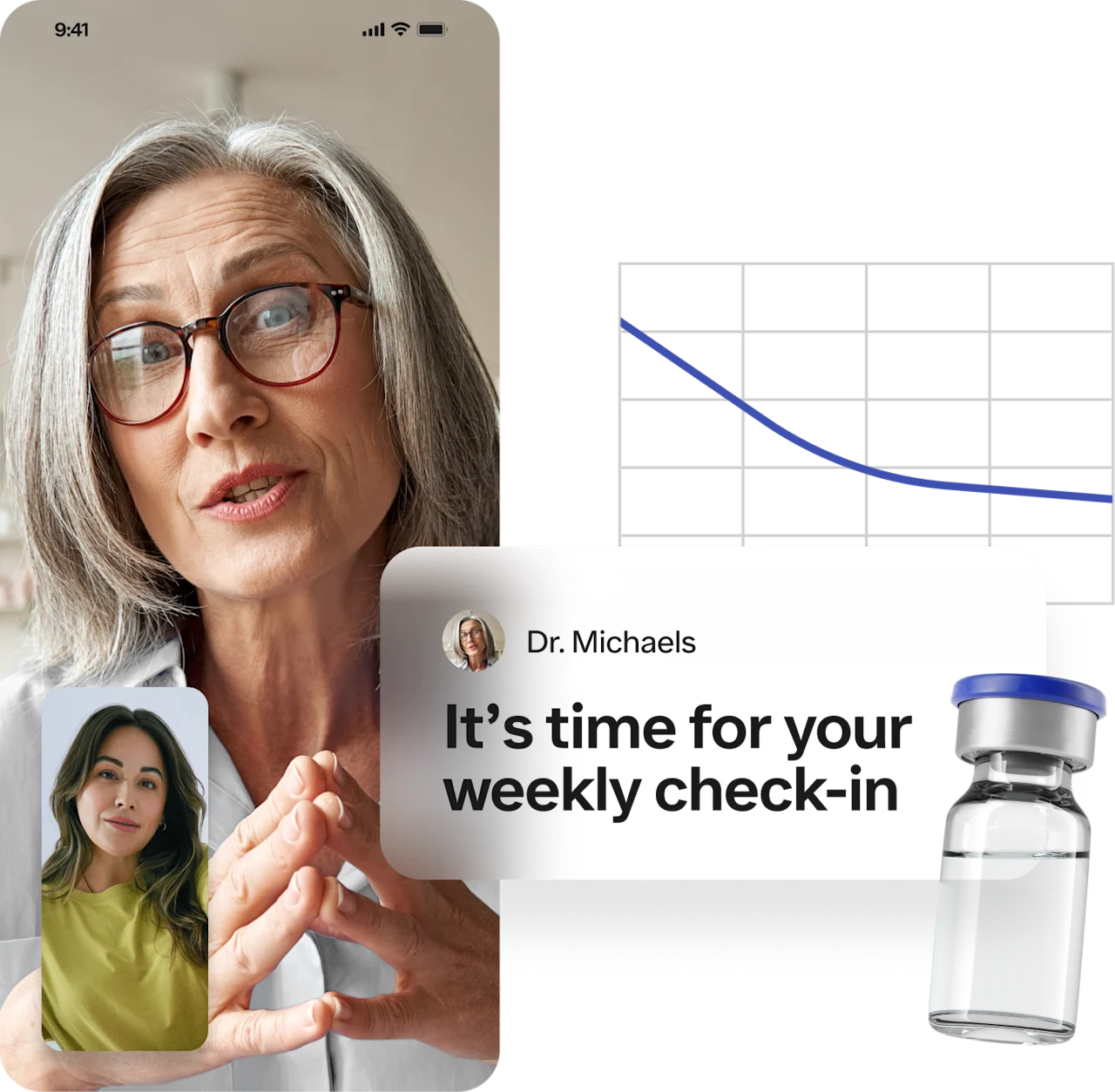Key takeaways
The "coffee loophole" for weight loss is a trend that suggests drinking coffee within 7 seconds of feeling hungry may help with weight loss.
Coffee, in moderation, might be a helpful addition to a weight loss plan due to potential effects on metabolism and appetite, but it should not be a main focus.
Sustainable weight loss comes from healthy lifestyle changes like a balanced diet, exercise, and enough sleep.
Here's what we'll cover
Here's what we'll cover
Here's what we'll cover
Key takeaways
The "coffee loophole" for weight loss is a trend that suggests drinking coffee within 7 seconds of feeling hungry may help with weight loss.
Coffee, in moderation, might be a helpful addition to a weight loss plan due to potential effects on metabolism and appetite, but it should not be a main focus.
Sustainable weight loss comes from healthy lifestyle changes like a balanced diet, exercise, and enough sleep.
When you’re on a weight loss journey, it’s natural to seek tips and tricks to help you reach your goals. From fad diets to weight loss “hacks,” it can be tempting to try the latest trend, like the so-called “coffee loophole” for weight loss. But does this method truly hold the key to shedding pounds? Let's dive into the science and explore the truth behind the 7-second weight loss coffee loophole.
What is the 7-second coffee loophole?
The 7-second coffee loophole is an online trend that has gained popularity on various social media platforms, such as YouTube and TikTok. There are variations of the coffee loophole for weight loss, but generally, it involves drinking a cup of black coffee with additives such as lemon, certain spices (e.g. cinnamon), or dietary supplements (e.g. L-carnitine, capsaicin) within 7 seconds of feeling hungry—regardless of the time of day.
Many of the proponents of the 7-second coffee loophole claim the technique can help suppress appetite, boost metabolism, and, in turn, promote rapid (and seemingly easy) weight loss results. However, it’s worth noting that lots of these people are also selling weight loss supplements, which can make their accounts of the coffee loophole method rather, err, questionable.
Nevertheless, there is some research that suggests drinking coffee may suppress appetite. As for the 7-second window and specific ingredients involved in the coffee loophole method, in particular? Let’s take a closer look.
Does the coffee loophole help weight loss?
Losing weight can be challenging and time consuming. So, the concept of a quick solution, such as that purportedly provided by the 7-second coffee loophole, may sound appealing.
But the effectiveness of this method is mainly unsupported by science.
That said, the caffeine in coffee and some of the ingredients social media users suggest adding to your brew may offer benefits that could indirectly support weight loss efforts.
Caffeine
Coffee contains caffeine, a stimulant that can increase your metabolic rate by 5–20% for at least 3 hours post-consumption, potentially leading to a small boost in the number of calories your body can burn at rest. Caffeine has also been shown to have moderate appetite-suppressing effects. Research suggests that consuming coffee 0.5–4 hours before a meal may reduce caloric intake. Although the same study also found that sipping on a cup of Joe 3–4.5 hours before eating did not have much of an effect on the amount consumed. So, coffee’s impact on appetite might depend on when you drink the beverage.
Other potential perks of caffeine (and, thus, coffee)? The stimulant can enhance exercise performance by reducing perceived exertion. Meaning, it can make a workout feel less challenging, allowing you to run longer, lift heavier, or engage in more intense exercises—all of which can promote weight loss. Caffeine may also be able to aid in fat loss by stimulating the release of fatty acids from fat cells, which are then used for energy. A 2020 study found that drinking 4 cups of coffee daily reduced body fat by approximately 4% over 24 weeks in people with overweight.
Cinnamon
Adding cinnamon to coffee may indirectly support weight loss by lowering pre- and post-meal blood sugar levels . The spice also contains compounds that can enhance your body’s insulin sensitivity by improving the transport of glucose (sugar) into cells. Insulin resistance can be harmful to the body, so anything that promotes insulin sensitivity can go towards improving your health.
MCT (medium-chain triglycerides) oil
Medium-chain triglyceride (MCT) oil is derived from coconut or palm kernel oil. MCTs are chains of fatty acids your body digests and convert into energy faster than long-chain triglycerides (fats) due to the way they are shaped. Evidence suggests MCT oil may enhance fat oxidation, helping the body use fat as an energy source to promote weight loss. One study found that people with overweight or obesity who took 2 grams of MCT oil daily for 2 weeks burned more fat during light exercise compared to those who took a placebo. MCT oil may also promote satiety (the feeling of fullness), potentially decreasing the likelihood of snacking between meals and reducing your overall caloric intake, which may support your weight loss goals. However, remember that MCT oil itself contains calories.
Lemon
An animal study found that giving mice lemon polyphenol supplements (antioxidant compounds in lemon) decreased body weight and body fat. They also seemed to improve insulin resistance—a condition where cells don’t respond effectively to the hormone, insulin—in mice. This suggests that lemon polyphenols may improve cells’ use of insulin and promote fat-burning for energy, potentially preventing or improving insulin resistance and obesity. While the study shows promise, this was an animal study and doesn't necessarily mean lemon polyphenols have the same effect in humans.
Is the coffee loophole safe?
Here are some risks to keep in mind that can be associated with too much coffee intake.
Depending on the amount of coffee you consume, the loophole method could lead to excessive caffeine intake and related symptoms, such as rapid heart rate, anxiety, insomnia, and digestive issues, among many others. Caffeine can also be addictive, leading to withdrawal symptoms—e.g. headache, fatigue, irritability, and depressed mood—if you suddenly cut it out of your diet. These negative effects can begin 12–24 hours after your last sip of coffee and continue for up to a week.
Coffee is acidic, as is lemon, which is often included in the 7-second coffee loophole. Both of these ingredients can not only damage tooth enamel, but they can also take a toll on sensitive stomachs. More specifically, acidic foods and beverages can worsen acid reflux symptoms (e.g. heartburn). What’s more, adding certain extra ingredients to your coffee, such as MCT oil, can increase the amount of calories and fats you consume, which could inhibit your weight loss goals.
Dietary supplements, such as those potentially added to coffee as part of the loophole method, are not regulated by the US Food and Drug Administration (FDA). This means there's no guarantee of these products' safety, purity, or effectiveness. The potential for unknown interactions with medications or underlying health conditions is also a concern, so it’s a good idea to talk to a healthcare provider before taking dietary supplements—or before trying anything new, including a weight loss trick like the coffee loophole.
The relationship between coffee and weight loss
Coffee's impact on weight loss is a topic of ongoing research, with some promising findings but no magic bullet solution. Here's a breakdown of the potential effects of coffee on body weight:
Increased metabolism: Studies show caffeine in coffee may modestly increase metabolic rate for a few hours, leading to a slight boost in the amount of calories burned at rest.
Enhanced fat burning: Coffee can help the body burn fat and use it as energy during exercise when consumed right before the workout.
Appetite suppression: Caffeine intake before eating during certain windows may help reduce calorie intake during meals.
Alternatives to the coffee loophole for weight loss
Sustainable weight loss is best achieved through healthy lifestyle habits, not quick fixes or shortcuts like the coffee loophole. A balanced diet, regular exercise, and good-quality sleep are just some of the many proven strategies that can help you reach your weight loss goals.
Reduce caloric intake
This means consuming fewer calories than your body needs to maintain your current weight. Burning more calories than you consume creates a caloric deficit, which prompts the body to use stored fat for energy and can ultimately lead to weight loss. Being mindful of the portion size of your meals and snacks can help you meet your daily caloric intake goals. Consider using smaller plates and bowls and pre-portioned snacks to avoid overeating.
Follow a balanced diet and drink lots of water
Eating a variety of nutrient-dense foods from all food groups can ensure your body gets the essential vitamins, minerals, and nutrients it needs to function properly in all areas, including metabolism. Here's what your plate might look like:
Half your plate: Filled with colorful fruits and vegetables, providing vitamins, minerals, and fiber to keep you full and energized.
A quarter of your plate: Lean protein sources like fish, chicken, beans, or tofu are necessary for building and maintaining lean muscle mass.
A quarter of your plate: Whole grains like brown rice, quinoa, or whole-wheat bread for sustained energy and healthy fiber intake.
Drinking plenty of water is also essential for weight loss. Sometimes, thirst can be mistaken for hunger pangs; drinking water before reaching for a snack can help you distinguish between hunger and dehydration. Research shows that drinking a glass of water about 30 minutes before meals can help you eat less by making you feel fuller.
Exercise regularly
Regular exercise is essential for weight loss and long-term health (think: reduced risk of chronic diseases, boosted mood). Physical activity helps burn calories, build muscle, and boost metabolism. Combining aerobic exercises, such as walking, running, or cycling, with strength training exercises, like weightlifting or bodyweight exercises, can provide the best results. It is generally recommended that most adults aim for at least 150 minutes of moderate-intensity aerobic activity per week and muscle-strengthening activities on 2 or more days per week.
Get more sleep
Getting enough shut-eye is essential for weight management and overall wellbeing. Poor sleep can disrupt the balance of hormones that regulate appetite, leading to increased hunger. Chronic sleep deprivation can also increase the risk of obesity and metabolic disorders, such as type 2 diabetes. Establish a regular sleep schedule, create a calming sleep environment, and aim for 7-9 hours of quality sleep each night.
Consider weight loss medications
Weight loss medications can be a valuable tool in combination with lifestyle changes if you struggle to lose weight through lifestyle habits alone. When combined with a balanced diet and regular exercise, GLP-1 weight loss medications, such as Wegovy (semaglutide), can help reduce appetite and promote weight loss. In clinical trials of Wegovy, for example, participants lost around 16% of their body weight after about 16 months of treatment combined with diet and exercise.
Interested in learning more about your options? You can talk to a healthcare provider in real life or virtually, such as through Ro, which offers access to weight loss medications and provides personalized support to help you achieve your weight loss goals safely and effectively.
Wegovy Important Safety Information: Read more about serious warnings and safety info.
DISCLAIMER
If you have any medical questions or concerns, please talk to your healthcare provider. The articles on Health Guide are underpinned by peer-reviewed research and information drawn from medical societies and governmental agencies. However, they are not a substitute for professional medical advice, diagnosis, or treatment.
References
Alperet, D. J., Rebello, S. A., Khoo, E. Y., et al. (2020). The effect of coffee consumption on insulin sensitivity and other biological risk factors for type 2 diabetes: a randomized placebo-controlled trial. The American Journal of Clinical Nutrition, 111(2), 448–458. doi: 10.1093/ajcn/nqz306. Retrieved from https://pubmed.ncbi.nlm.nih.gov/31891374/
Anderson, E. & Durstine, J. L. (2019). Physical activity, exercise, and chronic diseases: A brief review. Sports Medicine and Health Science, 1(1), 3–10. doi: 10.1016/j.smhs.2019.08.006. Retrieved from https://www.ncbi.nlm.nih.gov/pmc/articles/PMC9219321/
Carbone, J. W. & Pasiakos, S. M. (2019). Dietary Protein and Muscle Mass: Translating Science to Application and Health Benefit. Nutrients, 11(5), 1136. doi: 10.3390/nu11051136. Retrieved from https://www.ncbi.nlm.nih.gov/pmc/articles/PMC6566799/
Centers for Disease Control and Prevention (CDC). (2024). What you can do to meet physical activity recommendations. Retrieved from https://www.cdc.gov/physical-activity-basics/guidelines/index.html
Collado-Mateo, D., Lavín-Pérez, A. M., Merellano-Navarro, E., & Coso, J. D. (2020). Effect of Acute Caffeine Intake on the Fat Oxidation Rate during Exercise: A Systematic Review and Meta-Analysis. Nutrients, 12(12), 3603. doi: 10.3390/nu12123603. Retrieved from https://pubmed.ncbi.nlm.nih.gov/33255240/
Conger, S. A., Tuthill, L. M., & Millard-Stafford, M. L. (2022). Does Caffeine Increase Fat Metabolism? A Systematic Review and Meta-Analysis. International Journal of Sport Nutrition and Exercise Metabolism, 33(2), 112–120. doi: 10.1123/ijsnem.2022-0131. Retrieved from https://pubmed.ncbi.nlm.nih.gov/36495873/
Cooper, C. B., Neufeld, E. V., Dolezal, B. A., & Martin, J. L. (2018). Sleep deprivation and obesity in adults: a brief narrative review. BMJ Open Sport & Exercise Medicine, 4(1), e000392. doi: 10.1136/bmjsem-2018-000392. Retrieved from https://www.ncbi.nlm.nih.gov/pmc/articles/PMC6196958/
Fukuchi, Y., Hiramitsu, M., Okada, M., et al. (2008). Lemon Polyphenols Suppress Diet-induced Obesity by Up-Regulation of mRNA Levels of the Enzymes Involved in beta-Oxidation in Mouse White Adipose Tissue. Journal of Clinical Biochemistry and Nutrition, 43(3), 201–209. doi: 10.3164/jcbn.2008066. Retrieved from https://www.ncbi.nlm.nih.gov/pmc/articles/PMC2581754/
Hetherington, M. M., Blundell-Birtill, P., Caton, S. J., et al. (2018). Understanding the science of portion control and the art of downsizing. The Proceedings of the Nutrition Society, 77(3), 347–355. doi: 10.1017/S0029665118000435. Retrieved from https://www.ncbi.nlm.nih.gov/pmc/articles/PMC6088523/
Jadhav, H. B. & Annapure, U. S. (2023). Triglycerides of medium-chain fatty acids: a concise review. Journal of Food Science and Technology, 60(8), 2143–2152. doi: 10.1007/s13197-022-05499-w. Retrieved from https://www.ncbi.nlm.nih.gov/pmc/articles/PMC9217113/
Jeong, J. N. (2018). Effect of Pre-meal Water Consumption on Energy Intake and Satiety in Non-obese Young Adults. Clinical Nutrition Research, 7(4), 291–296. doi: 10.7762/cnr.2018.7.4.291. Retrieved from https://pubmed.ncbi.nlm.nih.gov/30406058/
Kim, J. Y. (2021). Optimal Diet Strategies for Weight Loss and Weight Loss Maintenance. Journal of Obesity & Metabolic Syndrome, 30(1), 20–31. doi: 10.7570/jomes20065. Retrieved from https://www.ncbi.nlm.nih.gov/pmc/articles/PMC8017325/
Kizilaslan, N. & Erdem, N. Z. (2019). The Effect of Different Amounts of Cinnamon Consumption on Blood Glucose in Healthy Adult Individuals. International Journal of Food Science, 2019, 4138534. doi: 10.1155/2019/4138534. Retrieved from https://www.ncbi.nlm.nih.gov/pmc/articles/PMC6425402/
Maher, T., Sampson, A., Goslawska, M., et al. (2019). Food Intake and Satiety Response after Medium-Chain Triglycerides Ingested as Solid or Liquid. Nutrients, 11(7), 1638. doi: 10.3390/nu11071638. Retrieved from https://www.ncbi.nlm.nih.gov/pmc/articles/PMC6683029/
Martins, G. L., Guilherme, J. P. L. F., Ferreira, L. H. B., et al. (2020). Caffeine and Exercise Performance: Possible Directions for Definitive Findings. Frontiers in Sports and Active Living, 2, 574854. doi: 10.3389/fspor.2020.574854. Retrieved from https://www.ncbi.nlm.nih.gov/pmc/articles/PMC7739593/
McKiernan, F., Houchins, J. A., & Mattes, R. D. (2008). Relationships between human thirst, hunger, drinking, and feeding. Physiology & Behavior, 94(5), 700–708. doi: 10.1016/j.physbeh.2008.04.007. Retrieved from https://www.ncbi.nlm.nih.gov/pmc/articles/PMC2467458/
Mohsin, S. N., Saleem, F., Humayun, A., et al.(2023). Prospective Nutraceutical Effects of Cinnamon Derivatives Against Insulin Resistance in Type II Diabetes Mellitus-Evidence From the Literature. Dose-response : A Publication of International Hormesis Society, 21(3), 15593258231200527. doi: 10.1177/15593258231200527. Retrieved from https://www.ncbi.nlm.nih.gov/pmc/articles/PMC10494518/
Rubino, D. M., Greenway, F. L., Khalid, U., et al. (2022). Effect of Weekly Subcutaneous Semaglutide vs Daily Liraglutide on Body Weight in Adults With Overweight or Obesity Without Diabetes: The STEP 8 Randomized Clinical Trial. JAMA, 327(2), 138–150. doi: 10.1001/jama.2021.23619. Retrieved from https://pubmed.ncbi.nlm.nih.gov/35015037/
Saads Carvalho, T. & Lussi, A. (2020). Chapter 9: Acidic Beverages and Foods Associated with Dental Erosion and Erosive Tooth Wear. Monographs in Oral Science, 28, 91–98. doi: 10.1159/000455376. Retrieved from https://pubmed.ncbi.nlm.nih.gov/31940633/
Sajadi-Ernazarova, K. R., Anderson, J., Dhakal, A., et al. (2023). Caffeine Withdrawal. StatPearls. Retrieved from https://www.ncbi.nlm.nih.gov/books/NBK430790/
Schubert, M. M., Irwin, C., Seay, R. F., et al. (2017). Caffeine, coffee, and appetite control: a review. International Journal of Food Sciences and Nutrition, 68(8), 901–912. doi: 10.1080/09637486.2017.1320537. Retrieved from https://pubmed.ncbi.nlm.nih.gov/28446037/
Tsujino, S., Nosaka, N., Sadamitsu, S., & Kato, K. (2022). Effect of Continuous Ingestion of 2 g of Medium-Chain Triglycerides on Substrate Metabolism during Low-Intensity Physical Activity. Nutrients, 14(3), 536. doi: 10.3390/nu14030536. Retrieved from https://www.ncbi.nlm.nih.gov/pmc/articles/PMC8839453/
U. S. Department of Agriculture (USDA). (2022). Start simple with MyPlate. Retrieved from https://myplate-prod.azureedge.us/sites/default/files/2022-01/SSwMP%20Mini-Poster_English_Final2022_0.pdf
U.S. Food and Drug Administration (FDA). (2023). Facts about dietary supplements. Retrieved from https://www.fda.gov/news-events/rumor-control/facts-about-dietary-supplements
van Egmond, L. T., Meth, E. M. S., Engström, J., et al. (2023). Effects of acute sleep loss on leptin, ghrelin, and adiponectin in adults with healthy weight and obesity: A laboratory study. Obesity (Silver Spring, Md.), 31(3), 635–641. doi: 1002/oby.23616. Retrieved from https://pubmed.ncbi.nlm.nih.gov/36404495/
Wierzejska, R. (2012). Caffeine--common ingredient in a diet and its influence on human health. Roczniki Panstwowego Zakladu Higieny, 63(2), 141–147. Retrieved from https://pubmed.ncbi.nlm.nih.gov/22928360/
Zhang, H. & Speakman, J. (2024). The complexity of coffee and its impact on metabolism. The Journal of Endocrinology, JOE-24-0075. doi: 10.1530/JOE-24-0075. Retrieved from https://pubmed.ncbi.nlm.nih.gov/38885075/













